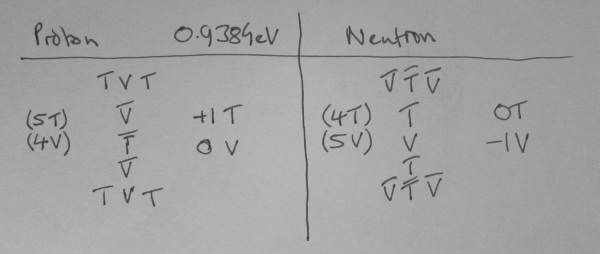Next: Rishon "I" Frame Up: Brief Introduction to the Previous: Expanded Rishon Model Particles Contents
 figureProton and Neutron Rishon Model structure
figureProton and Neutron Rishon Model structure
|
The proton has, as expected, a +1T (electrical) charge and the neutron has 0 electrical charge. However: note that whilst the proton has a zero V charge, the neutron has a negative (-1) V charge. From this we quite reasonably surmise that the neutrino has a positive V charge, on the grounds that the electron has the opposite T charge from a proton.
We lay out the Proton and Neutron in this shape as a way to express spin characteristics. It is believed that this is actually how the larger (composite) particles generate spin. Under investigation for additional possible explanations however are further toroidal knots (in this case the 10,3 pattern).
Observe in the proton how the end
![]() particles of the down
quark line up with the central V particles of the up quarks at either end.
In this way the two up quarks may safely themselves spin, and at the same
time the whole "I-shaped" assembly may rotate, thus providing from an
external perspective the observed spin characteristics noted of protons
in current particle physics models. This arrangement also places a
natural explanation for a limit on certain combinations of Rishons.
particles of the down
quark line up with the central V particles of the up quarks at either end.
In this way the two up quarks may safely themselves spin, and at the same
time the whole "I-shaped" assembly may rotate, thus providing from an
external perspective the observed spin characteristics noted of protons
in current particle physics models. This arrangement also places a
natural explanation for a limit on certain combinations of Rishons.
lkcl 2017-01-03